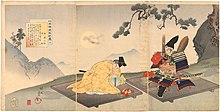Minamoto no Yoshimitsu
This article needs additional citations for verification. (January 2009) |
Minamoto no Yoshimitsu | |
|---|---|
 | |
| Native name | 源 義光 |
| Other name(s) | Shinra Saburō |
| Born | 1045 |
| Died | November 25, 1127 (aged 81–82) |
| Allegiance | Minamoto clan |
| Service | Kawachi Genji |
| Unit | Minamoto no Yoshiie Minamoto no Yoshitsuna |
| Battles / wars | Later Three-Year War |
Minamoto no Yoshimitsu (源 義光, 1045 – November 25, 1127) was a Japanese samurai lord during the Heian period. He served as Governor of Kai Province. He is credited as the ancient progenitor of the Japanese martial art, Daitō-ryū aiki-jūjutsu and Takeda-ryū.
Biography
[edit]
Yoshimitsu was born the son of Chinjufu-shōgun Minamoto no Yoriyoshi (988-1075) of the Minamoto clan. His brother was the Minamoto no Yoshiie. He was also known as Shinra Saburō (新羅 三郎), a nickname that comes from the Shinra Zenjindo Hall of Mii-dera Temple, where he had his coming-of-age ceremony. His Dharma name was Senkōin Shuntoku Sonryō (先甲院峻徳尊了). Ōe no Masafusa taught Yoshimitsu the Sho. He was skilled in horsemanship and archery.
According to Daitō-ryū's initial history, Yoshimitsu dissected the corpses of men killed in battle, and studied them for the purpose of learning vital point striking (kyusho-jitsu) and joint lock techniques. Daitō-ryū takes its name from that of a mansion that Yoshimitsu lived in as a child, called "Daitō", in Ōmi Province (modern-day Shiga Prefecture).
For military service during the Later Three-Year War (1083–1089), Yoshimitsu was made Governor of Kai Province (modern-day Yamanashi Prefecture), where he settled. He fought his nephew Minamoto no Yoshikuni over land. When his older brother Yoshiie died he planned the death of his nephew and fourth generational Kawachi Genji leader Minamoto no Yoshitada because he wanted to be the leader of the clan. He then blamed his brother Minamoto no Yoshitsuna for Yoshitada’s death.
Yoshimitsu's son, Minamoto no Yoshikiyo, took the surname "Takeda" and is also known as Takeda Yoshikiyo, and the techniques Yoshimitsu discovered would be secretly passed down within the Takeda clan until the late 19th century, when Takeda Sokaku (Daitō-ryū) and Oba Ichio (Takeda-ryū) have started to teach them to the public. He is the ancestor of the Takeda clan.
One of Japan's oldest flags is housed at the Unpo-ji temple in Kōshū city, Yamanashi Prefecture. Legend states it was given by Emperor Go-Reizei to Minamoto no Yoshimitsu and has been treated as a family treasure by the Takeda clan for the past 1,000 years,[1] and at least it is older than 16th century.
Family
[edit]- Father: Chinjufu-shōgun Minamoto no Yoriyoshi
- Mother: daughter of Taira no Naokata
- Wife: daughter of Taira no Kiyomoto, of the Hitachi Heishi (Taira) branch
- Children:
- Minamoto no Yoshinori (Satake)
- Minamoto no Yoshikiyo (Takeda)
- Minamoto no Moriyoshi (Hiraga)
- Minamoto no Chikayoshi (Okada)
References
[edit]- ^ Hongo, Jun. Hinomaru, 'Kimigayo' express conflicts both past and future. The Japan Times. 17 July 2007 [archived 18 July 2012].

